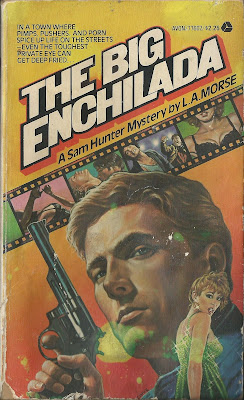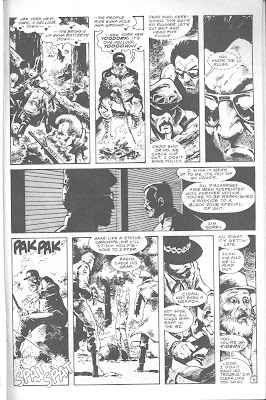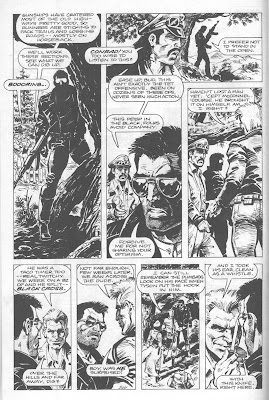4 / 5 Stars
L. A. Morse wrote several crime and horror novels in the late 70s and early 80s. One of these novels, The Flesh Eaters, is out of print and difficult to find, but a very worthwhile read, according to a review at the Too Much Horror Fiction Blog.
In the early 1990s Morse also wrote a two-volume guide to low budget movies, Video Trash Treasures Vol. 1 and Vol. II. (the early 90s were still the glory days of the videocassette).
'The Big Enchilada' (224 pp) was published by Avon Books in February 1982. A sequel, 'Sleaze', was published in 1985.
'Enchilada' is set in Los Angeles in the early 1980s and features rough-and-tough private eye Sam Hunter. Hunter takes the kind of cases that lead him into the down and dirty streets of the city, which is fine with Hunter, who is never too busy to run from a confrontation either with thugs, or crooked cops. Hunter also is never hesitant about providing his more attractive female clients with additional 'services'...........
As the novel opens, a six-foot-eight, 500 lb former wrestler and psychopath named Mountain bashes his way into Hunter's office and tosses the private eye against a wall, leaving with a threat: Stay Away from Domingo.
Of course, Hunter can't ignore a challenge, so he sets out to discover who Domingo is, and why he needs to threaten the life of a low-rent private eye. But Hunter's investigation is complicated by the presence of several additional cases:
High-end housewife Clarissa Acker wants to know if her wayward husband Simon is involved in something shady.
Wealthy magnate George Lansing wants to know if his spoiled brat of a son has been kidnapped.
Mel Perdue is worried about his fifteen year-old daughter, who ran away to Hollywood........and vanished.
As Hunter delves into the seedy underside of life in LA, he'll discover a thriving network of felons involved in porn, heroin, and murder........and more than a few of them are criminally insane...........
'The Big Enchilada' is an enjoyable read: fast-paced, with an intriguing cast of characters, all steeped in Southern California culture. Morse's depiction of Los Angeles in the summer, in all its stifling, polluted glory, makes the city a character in and of itself.
And Morse's writing style is so well calibrated for a hard-boiled novel that at times it reads more as a parody than as as an intentional effort at a noir composition:
The sun was starting to get low. This was always the hottest time, when the accumulated sweat of the day seemed to hang in the air and form an almost invisible haze. I didn't understand it, it used to be desert here, but it seemed to be getting increasingly humid. Put together, all the pools must add up to more inland water than the largest lake in the world, and the evaporated moisture couldn't get past the constant level of smog that hung at 2000 feet. This was getting to be a shitty place to live, and I'd go somewhere else if I thought there was any place better.
Morse imbues his action sequences with a crisp violence:
The other one moved at me. His eyes had the crazy gleam of the meth shooter. They showed sadistic pleasure. He rushed, the arm holding the knife straight out in front of him. I sidestepped, caught his wrist and slowly bent his arm back toward him. I covered his hand so that he could not let go of the knife, and as the blade moved closer to his head, the look in his eyes changed to terror. I let the knife blade rest on top of his ear for a second so that he would know what was going to happen. He started to scream as the blade cut into him, and as the ear was severed, warm blood gushed over my hand. He fell to his hands and knees, whimpering, and I brought my heel down hard on one of his hands, crushing it. I rotated my heel before lifting it.
The verdict ? 'The Big Enchilada' delivers as a hard-boiled crime novel; as an often laugh-out-loud satirical treatment of LA's crazier inhabitants; and as a pop-sociological study of the city in the early 80s. It's well worth picking up.
L. A. Morse wrote several crime and horror novels in the late 70s and early 80s. One of these novels, The Flesh Eaters, is out of print and difficult to find, but a very worthwhile read, according to a review at the Too Much Horror Fiction Blog.
In the early 1990s Morse also wrote a two-volume guide to low budget movies, Video Trash Treasures Vol. 1 and Vol. II. (the early 90s were still the glory days of the videocassette).
'The Big Enchilada' (224 pp) was published by Avon Books in February 1982. A sequel, 'Sleaze', was published in 1985.
'Enchilada' is set in Los Angeles in the early 1980s and features rough-and-tough private eye Sam Hunter. Hunter takes the kind of cases that lead him into the down and dirty streets of the city, which is fine with Hunter, who is never too busy to run from a confrontation either with thugs, or crooked cops. Hunter also is never hesitant about providing his more attractive female clients with additional 'services'...........
As the novel opens, a six-foot-eight, 500 lb former wrestler and psychopath named Mountain bashes his way into Hunter's office and tosses the private eye against a wall, leaving with a threat: Stay Away from Domingo.
Of course, Hunter can't ignore a challenge, so he sets out to discover who Domingo is, and why he needs to threaten the life of a low-rent private eye. But Hunter's investigation is complicated by the presence of several additional cases:
High-end housewife Clarissa Acker wants to know if her wayward husband Simon is involved in something shady.
Wealthy magnate George Lansing wants to know if his spoiled brat of a son has been kidnapped.
Mel Perdue is worried about his fifteen year-old daughter, who ran away to Hollywood........and vanished.
As Hunter delves into the seedy underside of life in LA, he'll discover a thriving network of felons involved in porn, heroin, and murder........and more than a few of them are criminally insane...........
'The Big Enchilada' is an enjoyable read: fast-paced, with an intriguing cast of characters, all steeped in Southern California culture. Morse's depiction of Los Angeles in the summer, in all its stifling, polluted glory, makes the city a character in and of itself.
And Morse's writing style is so well calibrated for a hard-boiled novel that at times it reads more as a parody than as as an intentional effort at a noir composition:
The sun was starting to get low. This was always the hottest time, when the accumulated sweat of the day seemed to hang in the air and form an almost invisible haze. I didn't understand it, it used to be desert here, but it seemed to be getting increasingly humid. Put together, all the pools must add up to more inland water than the largest lake in the world, and the evaporated moisture couldn't get past the constant level of smog that hung at 2000 feet. This was getting to be a shitty place to live, and I'd go somewhere else if I thought there was any place better.
Morse imbues his action sequences with a crisp violence:
The other one moved at me. His eyes had the crazy gleam of the meth shooter. They showed sadistic pleasure. He rushed, the arm holding the knife straight out in front of him. I sidestepped, caught his wrist and slowly bent his arm back toward him. I covered his hand so that he could not let go of the knife, and as the blade moved closer to his head, the look in his eyes changed to terror. I let the knife blade rest on top of his ear for a second so that he would know what was going to happen. He started to scream as the blade cut into him, and as the ear was severed, warm blood gushed over my hand. He fell to his hands and knees, whimpering, and I brought my heel down hard on one of his hands, crushing it. I rotated my heel before lifting it.
The verdict ? 'The Big Enchilada' delivers as a hard-boiled crime novel; as an often laugh-out-loud satirical treatment of LA's crazier inhabitants; and as a pop-sociological study of the city in the early 80s. It's well worth picking up.






































































